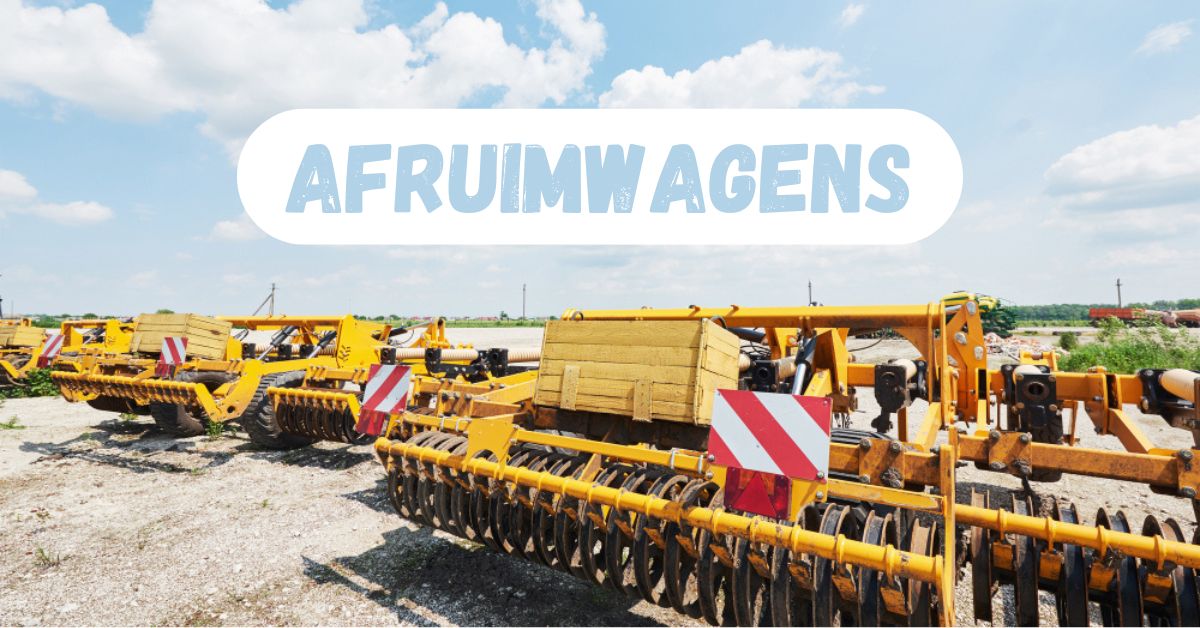In a world that’s constantly evolving, the quest for efficient and sustainable transportation solutions has never been more pressing. Enter Afruimwagens – the groundbreaking innovation poised to revolutionize how goods and people traverse our landscapes. Imagine a vehicle that not only minimizes carbon footprints but also maximizes productivity across various sectors! From agriculture to logistics, Afruimwagens are setting new standards in efficiency, combining cutting-edge technology with practical design. Join us as we delve into this exciting frontier of transportation, uncovering how these remarkable vehicles are reshaping industries and paving the way for a greener future. Buckle up; the journey is just beginning!
Introduction to Afruimwagens
As industries continue to evolve, the demand for efficient transportation solutions has never been more critical. Enter Afruimwagens—an innovative approach that is reshaping how we think about moving goods and services across various sectors. These versatile vehicles are not just a passing trend; they represent a significant leap forward in logistics, sustainability, and operational efficiency. Whether you’re in agriculture, construction, or retail, understanding the impact of Afruimwagens could transform your business practices and drive success. Join us as we delve into the fascinating world of Afruimwagens and uncover their potential to revolutionize transportation in diverse industries.
History and Evolution of Afruimwagens
Afruimwagens have a rich historical backdrop that dates back several decades. Originally designed for agricultural purposes, these vehicles were built to navigate challenging terrains while transporting goods efficiently.
Over time, advancements in technology transformed Afruimwagens into versatile machines. The integration of electric engines and improved materials has significantly enhanced their durability and efficiency. As industries evolved, so did the design and functionality of Afruimwagens. What began as simple transport solutions is now equipped with sophisticated features like GPS tracking and automated loading systems.
Today, they serve diverse sectors including construction, mining, and logistics. This evolution reflects an ongoing commitment to meeting the dynamic needs of various industries while prioritizing sustainability.
Types of Afruimwagens Used in Different Industries
Afruimwagens come in various forms, each tailored to specific industry needs. In agriculture, for instance, these vehicles are equipped with advanced features that allow farmers to transport goods efficiently from fields to markets.
In construction, specialized Afruimwagens facilitate the movement of heavy materials across job sites. Their robust design ensures they can handle rough terrains while maintaining stability and speed. The logistics sector also benefits significantly from Afruimwagens. Companies utilize them for last-mile delivery solutions due to their compact nature and maneuverability in urban settings.
Moreover, the mining industry employs larger variants designed for bulk material handling. These rugged models withstand harsh environments while ensuring safe transportation of resources. Each type reflects a commitment to efficiency and adaptability across diverse sectors. The evolution of Afruimwagens continues as industries demand more innovative solutions for their transportation challenges.
Advantages of Using Afruimwagens for Transportation
Afruimwagens bring a host of advantages that make them an appealing choice for transportation across various sectors. Their design focuses on efficiency, allowing businesses to optimize their logistics and streamline operations.
One major benefit is reduced operational costs. With lower fuel consumption and minimal maintenance needs, companies can save money while still ensuring timely deliveries. Another advantage lies in their versatility. Afruimwagens are adaptable, easily modified to suit specific industry requirements—from agriculture to construction—making them invaluable assets.
Safety features embedded in Afruimwagens enhance protection for both operators and cargo. Robust designs reduce the risk of accidents during transport. Moreover, these vehicles contribute positively to sustainability efforts. By utilizing advanced technology, they emit fewer pollutants compared to traditional transportation methods, aligning with eco-friendly initiatives that many companies prioritize today.
How Afruimwagens Promote Efficiency and Versatility
Afruimwagens stand out for their ability to adapt seamlessly to various operational needs. Their design enables quick modifications, allowing businesses in different sectors to customize features for specific tasks.
The lightweight structure of Afruimwagens enhances fuel efficiency, providing an eco-friendly solution that reduces operating costs. This makes them attractive not only for large enterprises but also for small businesses looking to optimize budgets. Another aspect of their versatility lies in the diverse terrains they can navigate. From rugged construction sites to smooth urban streets, Afruimwagens deliver reliable performance across multiple environments.
Moreover, the ease of loading and unloading materials streamlines processes significantly. Time-saving capabilities mean employees can focus on other essential tasks rather than logistics bottlenecks. As industries evolve, so do the demands placed on transportation methods. Afruimwagens meet these challenges head-on by offering innovative solutions that enhance productivity while maintaining flexibility.
Case Studies: Real Life Examples of Successful Implementation of Afruimwagens
In the heart of an agricultural region, a local farm adopted Afruimwagens to streamline its logistics. This transition allowed them to transport produce efficiently from fields to market. The result? A significant reduction in spoilage and improved delivery times.
Another remarkable example comes from a construction company that integrated Afruimwagens into its material handling processes. By replacing traditional vehicles, they boosted productivity on site while minimizing fuel costs. Workers were pleased with the enhanced maneuverability.
A logistics firm also reaped benefits by implementing Afruimwagens into its fleet. They witnessed faster loading and unloading times at distribution centers, leading to higher customer satisfaction rates. These case studies highlight how various sectors leverage Afruimwagen technology for tangible gains, further proving its versatility across diverse industries.
The Future of Afruimwagens in Transportation
The future of Afruimwagens looks promising as industries continue to evolve. These innovative transport solutions are set to revolutionize how goods are moved. With advancements in technology, Afruimwagens can integrate smart features. This includes real-time tracking and automated load management. Such integrations enhance efficiency and reduce human error.
Sustainability is another key aspect. As businesses strive for eco-friendly operations, Afruimwagens offer a way forward. Electric models are emerging, minimizing carbon footprints while maximizing performance. Furthermore, the adaptability of Afruimwagens allows them to cater to diverse sectors. From agriculture to construction, their versatility remains unmatched in meeting specific needs efficiently.
As demand increases, manufacturers will focus on improving design and functionality. The aim will be to create lighter yet more durable vehicles that can handle heavier loads effortlessly. Innovation combined with sustainability places Afruimwagens at the forefront of transportation’s next chapter.
Challenges and Limitations of Using Afruimwagens
Despite their many advantages, Afruimwagens face a few challenges in adoption and usage. One major limitation is the initial investment cost. Many companies hesitate to transition from traditional methods due to budget constraints.
Maintenance can also be an issue. Regular servicing is crucial for optimal performance, which may not always be readily available in all regions. Furthermore, infrastructure compatibility poses another challenge. Not every area has the necessary facilities or roads designed for Afruimwagens, limiting where they can operate effectively.
Training personnel on how to use these vehicles safely and efficiently requires time and resources. This need for specialized knowledge can slow down implementation across various sectors.
Lastly, there are regulatory hurdles that different jurisdictions impose on using new transport technologies like Afruimwagens. Compliance with evolving laws adds complexity to their widespread acceptance and integration into existing systems.
Conclusion: Why We Should Embrace the Use of Afruimwagens in Various Industries.
The use of Afruimwagens presents a transformative opportunity across multiple sectors. Their design and functionality cater to the unique demands of diverse industries, from agriculture to logistics. By integrating these innovative vehicles into transportation systems, businesses can enhance efficiency, reduce costs, and minimize their environmental footprint.
As we witness rapid advancements in technology and shifts toward sustainable practices, Afruimwagens stand out as a viable solution for modern-day challenges. The adaptability they offer means that organizations can meet varying needs while maintaining operational excellence.
Embracing Afruimwagens is not just about keeping pace with industry trends; it’s an investment in future readiness. As more companies recognize the advantages these vehicles bring—from improved productivity to enhanced safety—it becomes clear that adopting this mode of transport will be critical for success in today’s competitive landscape.
By championing the use of Afruimwagens now, industries position themselves advantageously for tomorrow’s innovations and changing market dynamics. This forward-thinking approach could very well define the next chapter in efficient transportation.

